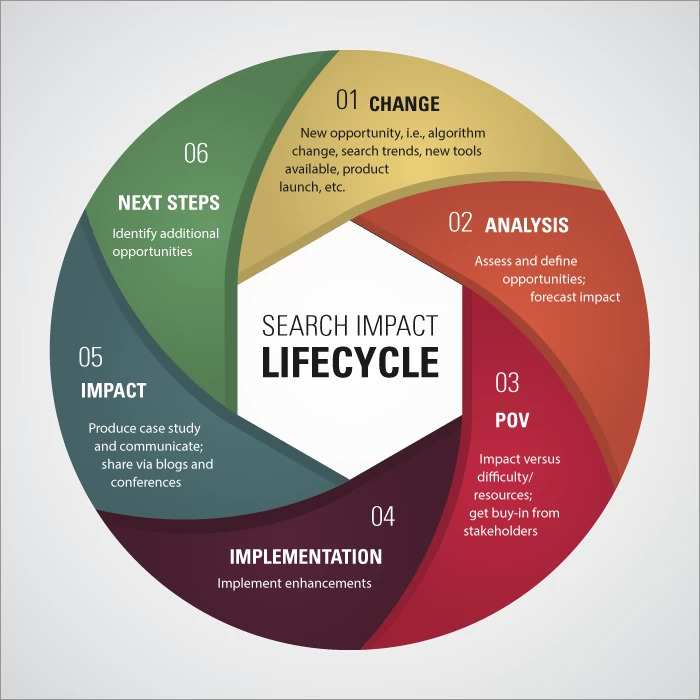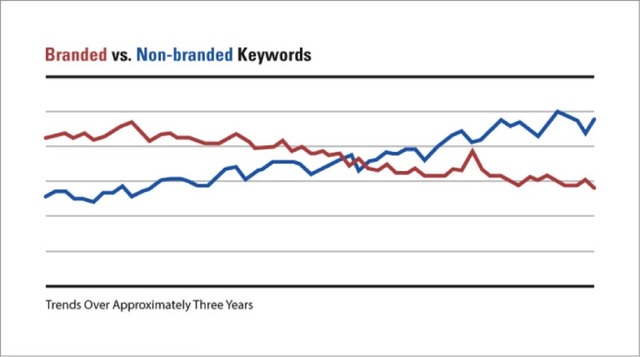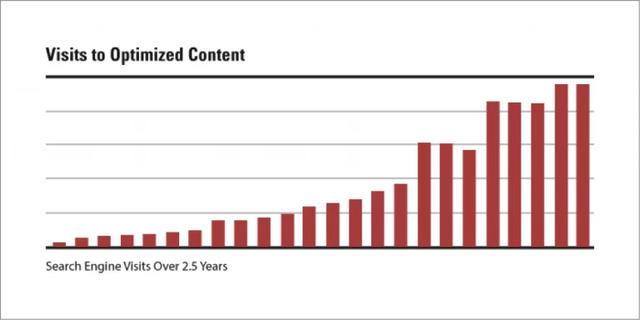SEO managers are often asked about the biggest challenge that they face when running SEO programs in large enterprise environments. While there are many areas that are critical for driving success, it’s hard to pinpoint just one area in the search impact lifecycle that’s the most crucial.
Sure, focusing on producing quality content is important. Yes, stakeholder engagement is needed to get things done. Theme-relevant linking is helpful. Defining strategy and aligning with business units, training and evangelism, data-driven decision making, technical SEO, search localization, testing, social engagement, reporting, and communication – all are must-haves.
However, at the end of the day, I think what’s tying these pieces together is a well-defined process plus flawless execution on tactics.
Today, we’ll cover how Adobe leveraged the those search impact lifecycle steps to implement a successful enterprise SEO strategy that brought more than 20 million SEO visits to one section of the Adobe.com site, increasing these types of visits from 4 percent to more than 60 percent in the first three years of the ongoing project.
Case Study: Search Impact Lifecycle in Action At Adobe
Changes in search patterns can influence SEO and a business’s content strategy. Here at Adobe, we identified a trend towards the use of non-branded keywords for one of our products. This suggested a need to create and optimize content focused on themes built around these new search terms – for example, topics about product features and functionalities - to maximize the search impact.
To help steer the SEO program in a fast-changing environment, we implemented the 6 steps of the search impact lifecycle:
- Change
- Analysis
- Point of view
- Implementation
- Impact
- Next steps
1. Change. The change phase happens frequently in the world of SEO, and presents us with new opportunities. We encounter algorithm adjustments – some are larger like Google Penguin, Panda and Hummingbird, while others are smaller, like branded versus non-branded keywords.
When we saw this particular change, we performed research to determine keywords that had high search demand, also adding conversion data to prioritize (at that time, keyword-level data was still available; with the new secure search, we can obtain this data from paid search programs).
The following graph is a representation of data for one top branded keyword and one top non-branded keyword, where the branded is red and non-branded is blue. The X-axis is time over approximately three years; the Y-axis is search demand.

2. Analysis. Next, we completed an analysis. The analysis of the change allows us to better define the opportunity and search impact based on external data or other sources/findings (i.e., testing), and forecast impact to help make a business case.
3. Point of view. Once we completed the analysis, we identified opportunity for the point of view (POV). The POV phase of the lifecycle is an opportunity to present a point of view, where we establish search impact versus difficulty of implementation (resources needed to enable certain enhancements).
At this time, the SEO team reaches out to various stakeholders in the organization to get buy-in, and rallies the forces behind the proposed enhancement.
Note: We often run a pilot to establish search impact more accurately before investing more resources into the project. Once the pilot proves successful, we expand. In this pilot, we created content for 15 pages focused on specific product features, targeting those high-value, non-branded keywords.
4. Implementation. The implementation phase was next. This is where we build the enhancement. In this instance, we optimized and published pages, ensuring that technical SEO was addressed such as page template coding, URL naming convention, page indexing and so on.
With a focus on user experience, the team validated with user groups that the messaging and presentation on the pages was adding value. We also tested and selected best-performing Title and Meta Description messaging to maximize click-through rate from search results, and worked on creating cross-links to these new pages from select theme-relevant pages to enhance user experience and help page indexing and theme.
Search engines indexed the new pages, established theme relevancy, and we started to see a steady progress over time for main SEO key performance indicators (KPIs).
5. Impact. Now it was time to analyze the search impact, using Adobe Analytics tools and the BrightEdge SEO platform.
We looked at the visibility of target non-branded keywords with the BrightEdge platform. Specifically, we were interested in the progress of rankings of preferred landing pages on the first page of Google search results.
The following screenshot is from the BrightEdge platform and shows the progress of the more than 120 value non-branded keywords we were tracking over the course of the project. The blue area of the bar represent Page 1 positions; the yellow areas, Page 2 positions; and the green areas, Page 3:

We also tracked business SEO KPIs including visits, trials and units sold, using the Adobe Analytics platform. Pages dedicated to non-branded optimization started to contribute to the business with an increasing pace;
After the first year, they brought more than 1.2 million SEO visits. Contribution of these pages to the overall SEO of the project increased from about 4 percent of all SEO visits at the beginning of the pilot to more than 60 percent at the close.
The following graph shows SEO visits to optimized content for a specific section at Adobe.com over a period of 3 years. The X-axis is time and Y-axis represents search engine visits:

The impact phase is where we have a chance to showcase the results of the project, and when we produce case studies, which help us get additional resources (to expand based on the pilot findings).
Impact analysis also allows our stakeholders to share success with extended teams, which helps us evangelize SEO throughout the company. We also share our case studies with industry peers and at conferences.
Based on the impact case study, we proceeded to identify additional opportunities and expanded content themes and optimization to cover more feature details, as well as expanded optimization to geo-targets.
6. Next Steps. As the next steps, we discovered additional opportunities, armed with the solid impact case study.
The Search Impact Lifecycle is a strategic framework for approaching SEO in a enterprise environment. Taking a methodical approach to how changes are made within the business’s Web marketing environment helps ensure the value of SEO is being realized every step of the way.
More...
In future posts, I’ll cover other case studies on how the Search Impact Lifecycle allows brands to steer SEO projects easier, including technical SEO, geo-targeting, SEO testing, and more.


